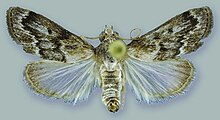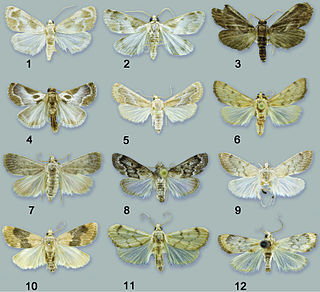
Schacontia is a genus of moths of the family Crambidae described by Harrison Gray Dyar Jr. in 1914.

Palpita maritima is a moth in the family Crambidae. The species was first described by J. Bolling Sullivan and Maria Alma Solis in 2013. It is found in the United States in Alabama, North Carolina and Florida. The habitat consists of coastal maritime forests.

Schacontia medalba is a moth of the family Crambidae described by William Schaus in 1904. It is found in Brazil and Peru.

Schacontia chanesalis is a moth of the family Crambidae described by Herbert Druce in 1899. It is found in Mexico, Guatemala, Costa Rica and Venezuela.

Schacontia umbra is a moth of the family Crambidae described by Maria Alma Solis and Paul Z. Goldstein in 2013. It is found in central Ecuador.

Schacontia speciosa is a moth of the family Crambidae described by Maria Alma Solis and Paul Z. Goldstein in 2013. It is found in south-eastern Brazil.

Schacontia themis is a moth of the family Crambidae described by Maria Alma Solis and Paul Z. Goldstein in 2013. It is found on the Cayman Islands and in Brazil, Costa Rica, Cuba, the Dominican Republic, Florida, Jamaica, Mexico, Panama, Puerto Rico and Venezuela.

Schacontia rasa is a moth of the family Crambidae described by Maria Alma Solis and Paul Z. Goldstein in 2013. It is found in Mexico, Cuba and the Dominican Republic.

Schacontia clotho is a moth of the family Crambidae described by Maria Alma Solis and Paul Z. Goldstein in 2013. It is found in southern Ecuador.

Schacontia lachesis is a moth of the family Crambidae described by Maria Alma Solis and Paul Z. Goldstein in 2013. It is found in central Brazil and Bolivia.
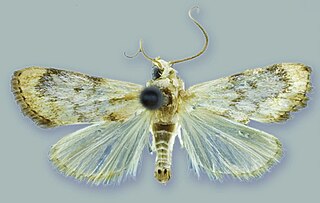
Schacontia atropos is a moth of the family Crambidae described by Maria Alma Solis and Paul Z. Goldstein. It is found in northern Venezuela.

Schacontia ysticalis is a moth of the family Crambidae described by Harrison Gray Dyar Jr. in 1925. It is found in Mexico, Costa Rica, Honduras, Nicaragua, Venezuela and Bolivia.
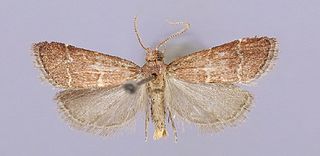
Heliades lindae is a species of moth of the family Pyralidae that is endemic to Arizona.

Glaphyriinae is a subfamily of the lepidopteran family Crambidae. It was described by William Trowbridge Merrifield Forbes in 1923. The subfamily currently comprises 509 species in 75 genera.
Cosmopterosis spatha is a moth in the family Crambidae. It was described by Maria Alma Solis in 2009. It is found in Costa Rica, where it has been recorded from the provinces of Alajuela, Guanacaste, Limon and Puntarenas. It is found at altitudes between 50 and 1,600 meters.
Cosmopterosis hispida is a moth in the family Crambidae. It was described by Maria Alma Solis in 2009. It is found in Brazil.

Frechinia helianthiales is a moth in the family Crambidae. It was described by Mary Murtfeldt in 1897. It is found in North America, where it has been recorded from Arizona, Illinois, Manitoba, Missouri and Oklahoma, south to Mexico.
Lamprosema sibirialis is a moth in the family Crambidae. It was described by Pierre Millière in 1879. It is found in Russia, Korea, China and Japan.
Syllepte nigriflava is a moth in the family Crambidae. It was described by Charles Swinhoe in 1894. It is found in the Indian states of Meghalaya and Sikkim.
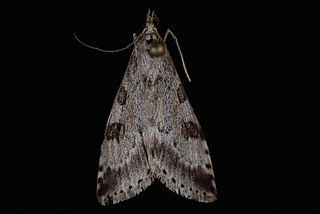
Udea washingtonalis, the Washington udea moth, is a moth in the family Crambidae. It was described by Augustus Radcliffe Grote in 1882. It is found in North America, where it has been recorded from Alaska, British Columbia, California, Montana and Washington.
